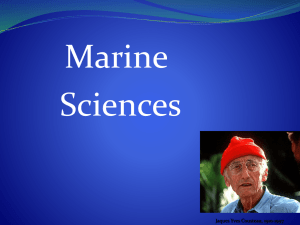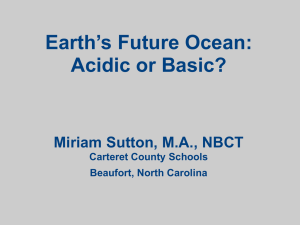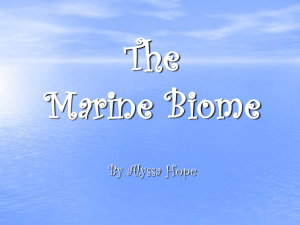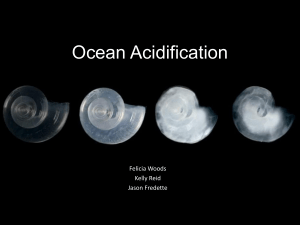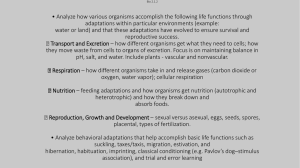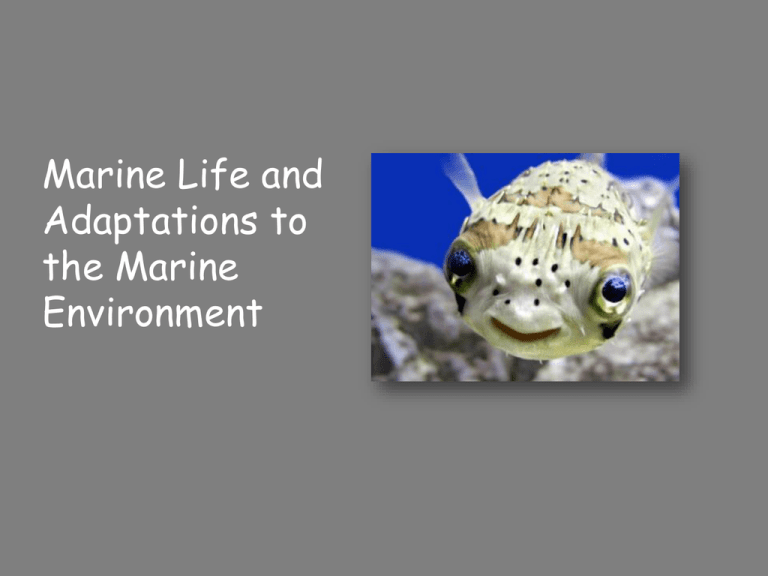
Marine Life and
Adaptations to
the Marine
Environment
Overview
More than 250,000 identified marine species
Most live in sunlit surface seawater
Classification of living organisms
Three domains of Life
Archaea
Prokaryotic, includes
“extremophile”
bacteria
Bacteria
Prokaryotic, includes
what used to be in
Kingdom Monera
Eukarya
Eukaryotic cells
Includes Protists,
Fungi, Plants, and
Animals
Domain Archaea
Bacteria - Prokaryotic cells
Cell wall differs from those bacteria in
Domain Bacteria
Includes extremophile bacteria
○ Acidophiles
○ Halophiles
○ Thermophiles
○ Etc.
○ These bacteria are found to chemosynthesize in
hydrothermal vents
Domain Bacteria
Bacteria – prokaryotic cells
Cell wall made of peptidoglycan
Includes Staphylococcus, Bacillus,
Vibrio, Pseudomonas, etc.
○ Only a very small % of bacteria are
pathogenic
○ Bacteria are very important in things like
nitrogen cycle, decomposition, food making,
etc.
Cyanobacteria are photosynthetic
bacteria
Archaea and Bacteria
○ Most numerous organisms on Earth!!
- Think about how much bacteria lives just on you
- Viruses are thought to out number bacteria but if you
are just talking about “live” organisms then bacteria
are the most numerous
○ Simplest of organisms
- But, can live in every thinkable habitat, even those
once thought to be unsuitable to life, very successful
organisms!!
Now we will talk about Domain Eukarya
○ Includes protists, fungi, plants, animals
Domain Eukarya
Protists:
Algae
○ Photosynthetic
○ Can be unicellular, colonial, or multicellular
- Multicellular - “seaweed” – kelp, sargassum, sea lettuce
- Unicellular – phytoplankton, produce majority of oxygen
in atmosphere comes from our phytoplankton, can cause
red tides (examples are dinoflagellates and diatoms)
Protozoans
○ Heterotrophic
○ Unicellular
○ Amoeba, paramecium
Domain Eukarya
Fungi
Heterotrophic
Secrete enzymes and absorb nutrition
Since they are heterotrophic, they are more closely
related to animals than to plants
Multicellular (mold) or unicellular (yeast)
Domain Eukarya
Plants
Autotrophic, multicellular
Many plant species cannot tolerate saltwater
○ Very few species grow in/near ocean
Sea grasses
Mangroves
Dune plants
Domain Eukarya
Animals
Heterotrophic, multicellular, have motility
at some point in life cycle
Wide variety
○ From simplest of animals (sponges) to most
complex (mammals)
Viruses
Acellular entities
○ Are they “alive”??? – many scientists say no
○ Do not have the machinery for life processes,
have to take over host cell
○ The ultimate “parasites”
○ Viruses very prevalent in the marine
environment
Taxonomic classification
Systemized classification of organisms
Kingdom
Phylum
Class
Order
Family
Genus
Species
Fundamental unit
Population of genetically similar, interbreeding
individuals
With new molecular methods (comparing
DNA sequence and amino acid sequences
of certain proteins), traditional taxonomy
is changing
○ Taxonomists are discovering new relationships
between species
○ Molecular data gives a clearer picture of
relatedness as opposed to the traditional ways
of classifying organisms:
- Morphology, embryology, behavior, habitat, etc.
Let’s take a closer look at Plant and
Animal taxonomy
Kingdom Plantae
○ Nonvascular Plants – mosses, etc
○ Vascular Plants
Seedless Vascular Plants – ferns, etc
Seed Vascular Plants
- Gymnosperms – “naked” seeds
- Angiosperms – flowering plants (in the marine
environment these include mangroves, sea
grasses, etc.)
Kingdom Animalia
Parazoa – no true embryonic tissues
○ Sponges
Eumetazoa – true embryonic tissues
○ 2 true tissues – radial symmetry; Cnidarians,
Ctenophores
○ 3 embryonic tissues – bilateral symmetry; all
other animals
Acoelomate – only flatworms
Coelomates:
- Protostomes
- Deuterostomes
Radially Symmetrical Animals, 2
true embryonic tissues
Cnidarians
○ Class Anthozoa – sea anemones, corals
○ Hydrozoa – Hydra
○ Scyphozoa – “jellies”
Ctenophores – no stinging cells,
complete gut unlike in the Cnidarians
What are the embryonic tissue layers?
Tissue layers that form during development
○ Ectoderm
○ Mesoderm
○ Endoderm
What is radial symmetry?
What is bilateral symmetry?
What is an acoelomate?
What is a coelomate?
Bilaterally symmetrical animals are divided
into 2 groups
Protostomes – 1st blastopore that forms during
development becomes the mouth
○ Includes Annelids, Arthropods, Molluscs
Deuterostomes – 1st blastopore that forms
during development becomes the anus
○ Includes the Echinoderms, Chordates
Bilaterally symmetrical animals
Platyhelminthes – flatworms
Protostomes
○ Annelids
○ Mollusks
○ Nematods
○ Arthropods
Deuterostomes
○ Echinoderms
○ Chordates
Platyhelminthes – flatworms
Class Turbellaria – free-living flatworms
Class Trematoda – flukes
Class Cestoda - tapeworms
http://ocean.nationalgeographic.com/ocean/photos/marine-worms/#/marine-worms03-flatworm_18260_600x450.jpg
Protostomes
Mullusca
Class Polyplacaphora - chitins
Class Gastropoda – snails, conchs
Class Bivalvia – oysers, scallops
Class Cephalopoda – squid, octopus
Protostomes
Annelida
Class Oligochaeta – earthworms
Class Polychaeta – many marine species,
sand worms, feather dusters
Class Hirudinea - leeches
Marine feather duster worm
http://www.aquariumdomain.com/viewMarineInvertSpecies.php?invert_marine_id=26
Protostomes
Nematoda – round worms
○ Many of these are parasitic
Protostomes
Arthropoda
Largest group of animals on the planet!!!!
Chelicerates – horseshoe crabs and arachnids
Crustaceans – marine and freshwater, crabs,
lobster, shrimp, barnacles
Insects and relatives
Limulus polyphemus
Callinectes sapidus
Deuterostomes
Echinodermata
Adults have pentahedral symmetry but
larvae are bilaterally symmetrical
Class Ophiuroidea – brittle stars
Class Echinodea – sea urchins
Class Holothuroidea – sea cucumber
Class Crinodea – sea lillies
Sea cucumber from IRL
Deuterostomes
Chordata
Characteristics: dorsal hollow nerve cord, notochord, post-anal tail,
pharyngeal gill slits
Subphylum Urochordata – tunicates
Larvae have bilateral symmetry, look like tadpole
Subphylum Cephalochordata – lancelets
Subphylum Vertebrata
○ Superclass Agnatha – jawless fishes
○ Superclass Gnathostoma – jaws
Class Chondrichthyes
Class Osteichthyes
Class Amphibia
Class Reptilia
Class Mammalia
Vertebrates
Class Chondrichthyes
Sharks, rays
Vertebrates
Class Osteichthyes
Bony fish, ray-finned fish
Great diversity in the ocean!
○ Very small to very large
○ Large tuna, grouper, sailfish
○ Deep sea fish
○ Flattened fish – flounder
○ Seahorses
○ Eels
Vertebrates
Class Reptilia
Includes birds now!!!
Sea turtles, sea snakes, pelicans, penguins,
osprey, sea gulls
http://seaturtlesofindia.org/?page_id=12
Vertebrates
Class Mammalia
What are the characteristics of mammals?
Carnivores: Sea otters, Polar bears, pinnepeds
(walruses, seals, sea lions)
Sirenians: manatees
Cetacea
○ Odontocetes – toothed whales: dolphins,
porpoises, sperm whale
○ Mysticetes: baleen whales: gray whale, right
whale, blue whale (largest animal to roam the
Earth)
Classification in the marine
environment by habitat and mobility
Plankton (floaters)
Nekton (swimmers)
Benthos (bottom dwellers)
http://i.ehow.com/images/GlobalPhoto/Articles/2110315/icephytoplankton-main_Full.jpg
Plankton
Most biomass on Earth consists of plankton
Phytoplankton
Microscopic algae, Autotrophic
Zooplankton
Heterotrophic
Protozoans, tiny animals, larvae of larger
animals
Bacterioplankton
Virioplankton
Viruses that infect bacteria and eukaryotic cells
Plankton
o
Holoplankton
o
o
o
Meroplankton
o
o
o
o
Part of lives as plankton
Juvenile or larval stages in the plankton
Examples are lobsters, some fish species, etc.
Macroplankton
o
o
Entire lives as plankton
Example is algae, protozoans, small microscopic
animals
Large floaters such as jellyfish or Sargassum
Picoplankton
o
Very small floaters such as bacterioplankton
Nekton
Independent
swimmers
Most adult fish
and squid
Marine reptiles
Marine mammals
Benthos
Epifauna live on surface
of sea floor
Infauna live buried in
sediments
Nektobenthos swim or
crawl through water
above seafloor
Most abundant in
shallower water
Number of marine species
More land species than marine species
Ocean relatively uniform conditions
Therefore, less adaptation required, less speciation
Don’t get this fact confused with # of individual organisms
There are fewer different species in the ocean but greater # of individuals
Majority of life on Earth lives in the ocean!!
Diversity in the ocean is high, also – think about different types of fish
(seahorses to sharks, for example)
Marine species overwhelmingly benthic rather than
pelagic
○ Most of these will be in shallow coastal benthic areas where
there is light and a lot of primary productivity
Marine organisms have a lot of
adaptations for living in the marine
environment
Let’s take a look at some of these
adaptations
Adaptations of marine organisms
Physical support
Buoyancy
How to resist sinking
Different support structures in cold (fewer)
rather than warm (more appendages)
seawater
Smaller size
http://www.solaster-mb.org/mb/images
Adaptations to marine life
Oil in micro-organisms to
increase buoyancy
○ Over-time, if these
organisms die and sink to
bottom
○ Can become offshore oil
deposits
Fish egg with oil droplet
Fig. 12.9
http://www.rpgroup.caltech.edu/~natsirt/aph162/webpages/dylanandco/lab1/image
Adaptations to marine life
Streamlining important for
larger organisms
Less resistance to fluid flow
Flattened body
Tapering back end –
fusiform
http://www.wissenschaft-online.de/sixcms/media.php/591
Fin designs in fish
Vertical fins as stabilizers
○ dosral and anal fins
Paired fins for “steering” and balance
○ Pelvic and pectoral
Tail fin (caudal) for thrust
http://www.biologycorner.com/resources/fish_fins.gif
Adaptations to marine life
Narrow range temperature in oceans
Smaller variations (daily, seasonally, annually)
Remember it takes longer to change water temp
than air temp
Deep ocean nearly isothermal
Adaptations to marine life
Cold- versus warm-water species
Smaller in cooler seawater
More appendages in warmer seawater
Why?
Tropical organisms grow faster, live shorter,
reproduce more often
Higher # of species in warmer seawater
Not necessarily higher # of individuals
More biomass in cooler seawater (upwelling)
Polar waters are much more productive
(more plankton growth) than tropical
waters
Adaptations to finding prey
Most fish coldblooded but some
are warm-blooded
Homeothermicbody temperature
above sea water
temperature
Modifications in
circulatory
system
Mainly in fastswimming fish
http://www.sciencedaily.com/images/2005/10/051031133653.jpg
Adaptations of deep-water nekton
Mainly fish that consume detritus or each
other
Lack of abundant food
Bioluminescence
○ http://www.ted.com/talks/edith_widder_glowing_life
_in_an_underwater_world.html
Fishing lures
Large,
sensitive eyes
Anglerfish
w/ males
http://www.antoranz.net/CURIOSA/ZBIOR2/C0301
Lanternfish
http://www.lifesci.ucsb.edu/~biolum/organism/pictures/myctophid1.jpg
Adaptations to marine life
Stenothermal
Organisms withstand small variation in
temperature
Typically live in open ocean
Eurythermal
Organisms withstand large variation in
temperature
Typically live in coastal waters
Adaptations to marine life
Stenohaline
Organisms withstand only small variation in
salinity
Typically live in open ocean
Euryhaline
Organisms withstand large variation in salinity
Typically live in coastal waters, e.g., estuaries
Adaptations to marine life
Extracting minerals from seawater
High concentration to low concentration
Diffusion
Cell membrane permeable to nutrients, for
example
Waste passes from cell to ocean
Adaptations to marine life
Osmotic pressure
Less concentrated
to more
concentrated
solutions
Isotonic
Hypertonic
Hypotonic
Adaptations to marine life
Dissolved gases
Some animals extract dissolved oxygen (O2)
from seawater through gills
Fig. 12.15
Adaptations to marine life
Water’s transparency
Many marine organisms see well
Some marine organisms are nearly
transparent to avoid predation
Adaptations to marine life
Camouflage through color patterns
Countershading
Disruptive coloring
http://www.youtube.com/watch?v=PmDTtkZl
MwM
http://theplasticocean.blogspot.com/2012_07_01_archive.html
Adaptations to marine life
Water pressure
Increases about 1 atmosphere (1 kg/cm2) with
every 10 m (33 ft) deeper
Many marine organisms do not have inner air
pockets
Collapsible rib cage (e.g., sperm whale)
Main divisions of the marine environment
Pelagic (open sea)
Neritic (< 200 m) and oceanic
Benthic (sea floor)
Subneritic and suboceanic
Another classification scheme:
Euphotic
Disphotic
Aphotic
Pelagic environments – Open ocean
Epipelagic
Mesopelagic
Bathypelagic
Abyssopelagic
Fig. 12.19
Benthic environments – ocean floor
Supralittoral
Transition from land to seafloor
Subneritic (under neritic)
Littoral
(intertidal zone)
Sublittoral
(shallow tidal
zone to 200m)
Suboceanic
Bathyal
(200-4,000m)
Abyssal
(4000-6000m)
Hadal
(below 6000m)
Fig. 12.19
Distribution of benthic organisms
Fig. 15.1
More benthic productivity when closely beneath areas of
high surface primary productivity
Mainly on continental shelves
Affected by surface ocean currents
Humans and coral reefs
Activities such as fishing,
tourist collecting, sediment
influx due to shore
development harm coral reefs
Sewage discharge and
agricultural fertilizers increase
nutrients in reef waters
corals thrive at low nutrient levels
Phytoplankton overwhelm at high
Coral covered with macroalgae
nutrient levels, limit light reaching
the corals
Bioerosion of coral reef by algaeeating organisms
http://daac.gsfc.nasa.gov/oceancolor/images/coral_reef_algae.jpg
Ocean Literacy Principles
3.e - The ocean dominates the Earth’s carbon cycle. Half the primary productivity on Earth
takes place in the sunlit layers of the ocean and the ocean absorbs roughly half of all
carbon dioxide added to the atmosphere.
5.a - Ocean life ranges in size from the smallest virus to the largest animal that has lived
on Earth, the blue whale.
5.b - Most life in the ocean exists as microbes. Microbes are the most important primary
producers in the ocean. Not only are they the most abundant life form in the ocean, they
have extremely fast growth rates and life cycles.
5c. - Some major groups are found exclusively in the ocean. The diversity of major groups
of organisms is much greater in the ocean than on land.
5.e - The ocean is three-dimensional, offering vast living space and diverse habitats from
the surface through the water column to the seafloor. Most of the living space on Earth is
in the ocean.
5.f - Ocean habitats are defined by environmental factors. Due to interactions of abiotic
factors such as salinity, temperature, oxygen, pH, light, nutrients, pressure, substrate and
circulation, ocean life is not evenly distributed temporally or spatially, i.e., it is “patchy”.
Some regions of the ocean support more diverse and abundant life than anywhere on
Earth, while much of the ocean is considered a desert.
5.g - There are deep ocean ecosystems that are independent of energy from sunlight and
photosynthetic organisms. Hydrothermal vents, submarine hot springs, methane cold
seeps, and whale falls rely only on chemical energy and chemosynthetic organisms to
support life.
Sunshine State Standards
SC.6.L.14.3 - Recognize and explore how cells of all organisms undergo similar
processes to maintain homeostasis, including extracting energy from food, getting
rid of waste, and reproducing.
SC.7.L.17.3 - Describe and investigate various limiting factors in the local
ecosystem and their impact on native populations, including food, shelter, water,
space, disease, parasitism, predation, and nesting sites.
SC.912.L.15.5 - Explain the reasons for changes in how organisms are classified.
SC.912.L.15.6 - Discuss distinguishing characteristics of the domains and
kingdoms of living organisms.
SC.912.L.17.2 - Explain the general distribution of life in aquatic systems as a
function of chemistry, geography, light, depth, salinity, and temperature.
SC.912.L.17.7 - Characterize the biotic and abiotic components that define
freshwater systems, marine systems and terrestrial systems.

